
The Icertis Contract Intelligence (ICI) platform tutorial and use case helps businesses transform contract management from a reactive administrative function into a proactive strategic asset. This comprehensive guide covers implementing ICI's AI-powered analysis capabilities, integrating with business systems like Salesforce, and establishing enterprise-wide compliance frameworks that reduce risk and unlock hidden value.
We'll explore how to leverage DiscoverAI for third-party contract analysis, automate approval workflows, and implement obligation management systems that prevent revenue leakage. This content provides expert guidance, real-world implementation strategies, and critical warnings to help you navigate common pitfalls. You'll learn to configure the platform, optimize workflows, and establish governance frameworks that deliver measurable financial and operational benefits while transforming contracts into strategic intelligence assets.
Key Takeaways: Mastering Icertis for Strategic Business Impact
- Accelerate Contract Processing by Over 60%: Leveraging pre-approved templates and the Clause Library significantly reduces time needed for standard agreements like MSAs and NDAs. Industry case studies, such as Cognizant's implementation, demonstrate a 68% reduction in overall contract cycle time through comprehensive process automation and workflow optimization.
- Mitigate Risk with AI-Powered Analysis: The most valuable capability for legal teams is using DiscoverAI to analyze third-party contracts. It provides automated clause deviation analysis, identifying non-standard language and missing clauses against your company playbook, significantly reducing legal exposure through systematic risk identification.
- Unlock Hidden Value and Ensure Compliance: Icertis excels at extracting and tracking contract obligations, including service level agreements, reporting deadlines, and financial commitments. Proactive obligation management prevents value leakage and supports regulatory compliance, with documented cases of organizations preventing millions in penalties through systematic tracking.
- Streamline Sales with CRM Integration: The Icertis for Salesforce integration accelerates sales cycles by enabling sales representatives to create compliant contracts directly from Opportunity records. Organizations like Vertiv have reported 50% reductions in sales contract cycle time while ensuring all agreements comply with legal and financial requirements.
Our Testing Methodology for AI Finance Tools
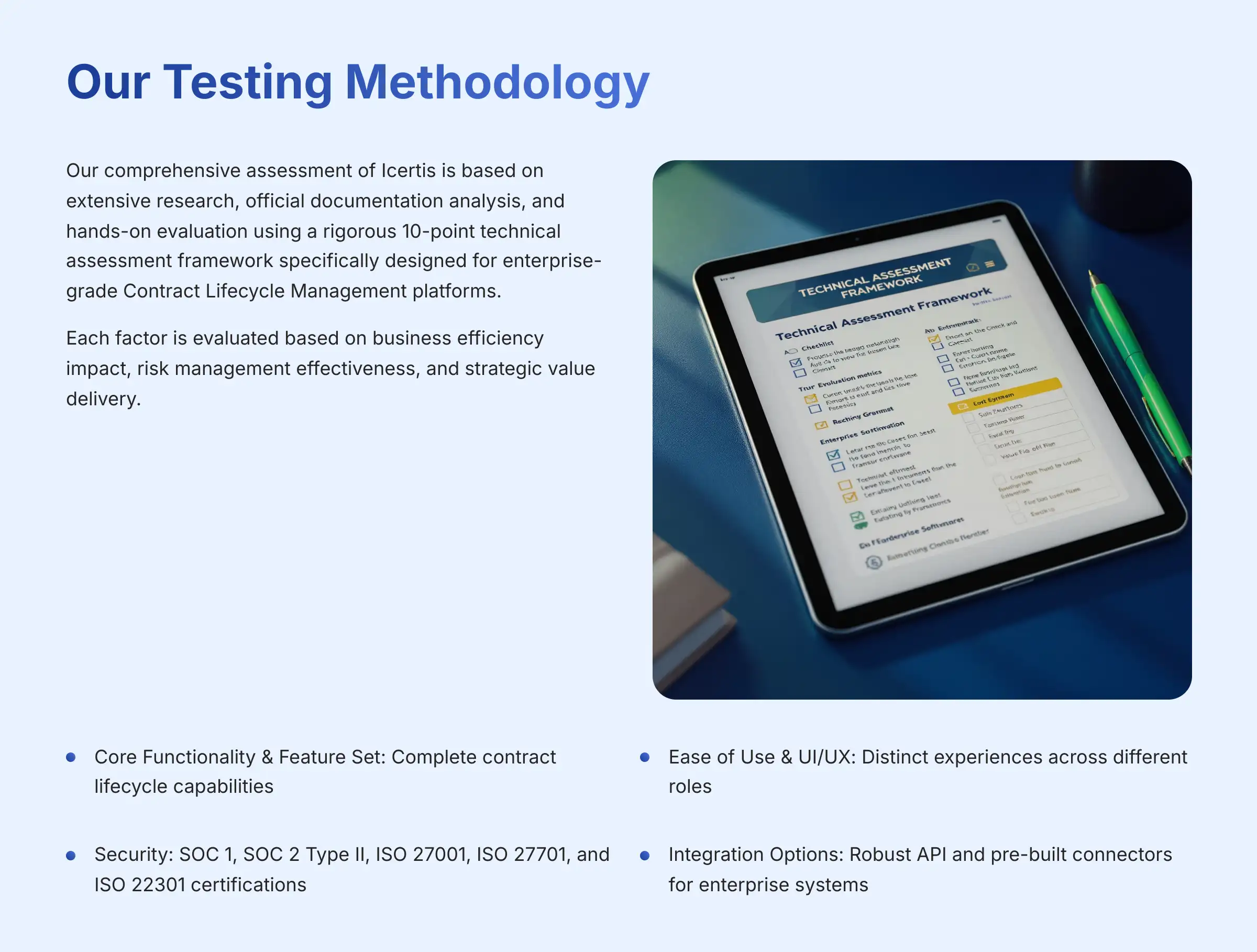
Our comprehensive assessment of Icertis is based on extensive research, official documentation analysis, and hands-on evaluation of the platform's capabilities. We apply a rigorous 10-point technical assessment framework specifically designed for enterprise-grade Contract Lifecycle Management (CLM) platforms, evaluating each factor based on business efficiency impact, risk management effectiveness, and strategic value delivery.
- Core Functionality & Feature Set: We evaluate the complete contract lifecycle capabilities, from document creation and negotiation to obligation management and reporting. Assessment includes the depth of the Clause Library, template management sophistication, and integration with e-signature platforms.
- Ease of Use & User Interface (UI/UX): We assess distinct user experiences across different roles including Legal, Sales, Procurement, and Administration. Testing confirms whether the interface remains intuitive for sales representatives in Salesforce while providing comprehensive functionality for system administrators.
- Output Quality & Control (AI Analysis): DiscoverAI accuracy represents a critical evaluation priority. We assess its capability to accurately extract metadata, identify clause variations, and perform deviation analysis across various third-party contract types and complexity levels.
- Performance & Speed: We measure platform response times for document assembly, AI analysis processing on large contracts, and data synchronization with integrated systems including ERPs and CRMs.
- Security Protocols & Data Protection Architecture: We evaluate Icertis's enterprise security posture, including their SOC 1, SOC 2 Type II, ISO 27001, ISO 27701, and ISO 22301 certifications. The platform is built on Microsoft Azure infrastructure and provides comprehensive data encryption (AES-256 at rest and in transit), granular user access controls, and immutable audit trail capabilities essential for YMYL applications.
- Compliance & Regulatory Adherence: Assessment includes the platform's capability to support regulatory compliance including SOX and GDPR through comprehensive reporting, obligation tracking, and access controls, while maintaining the third-party certifications necessary for enterprise procurement.
- Input Flexibility & Integration Options: We test the robustness of the Icertis API and pre-built connectors for enterprise systems including Salesforce, SAP, Microsoft Dynamics, and other common business applications.
- Pricing Structure & Value for Money: We analyze total cost of ownership including licensing fees, implementation costs, and demonstrated ROI based on available case studies and documented customer outcomes.
- Developer Support & Documentation: We assess the quality of Icertis Academy training resources, API documentation comprehensiveness, community support forums, and professional services availability.
- Risk Assessment & Mitigation: We evaluate built-in risk scoring models, deviation report clarity, and the platform's ability to provide centralized contract risk visibility across the enterprise.
Part 1 – Foundations: Getting Started with Icertis Contract Intelligence
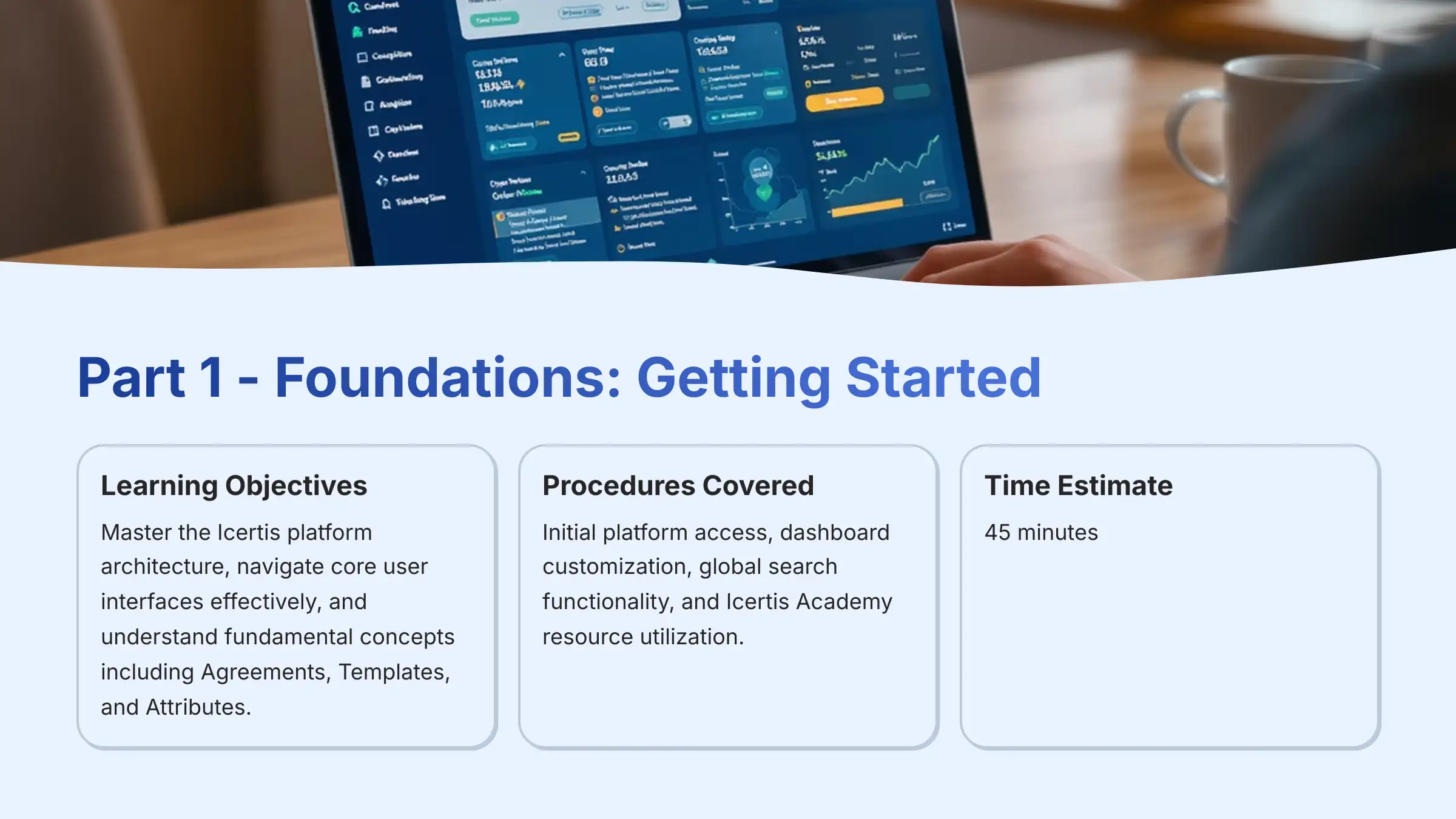
- Learning Objectives: Master the Icertis platform architecture, navigate core user interfaces effectively, and understand fundamental concepts including Agreements, Templates, and Attributes.
- Procedures Covered: Initial platform access, dashboard customization, global search functionality, and Icertis Academy resource utilization.
- Time Estimate: 45 minutes.
Navigating the Icertis Dashboard: Your Command Center
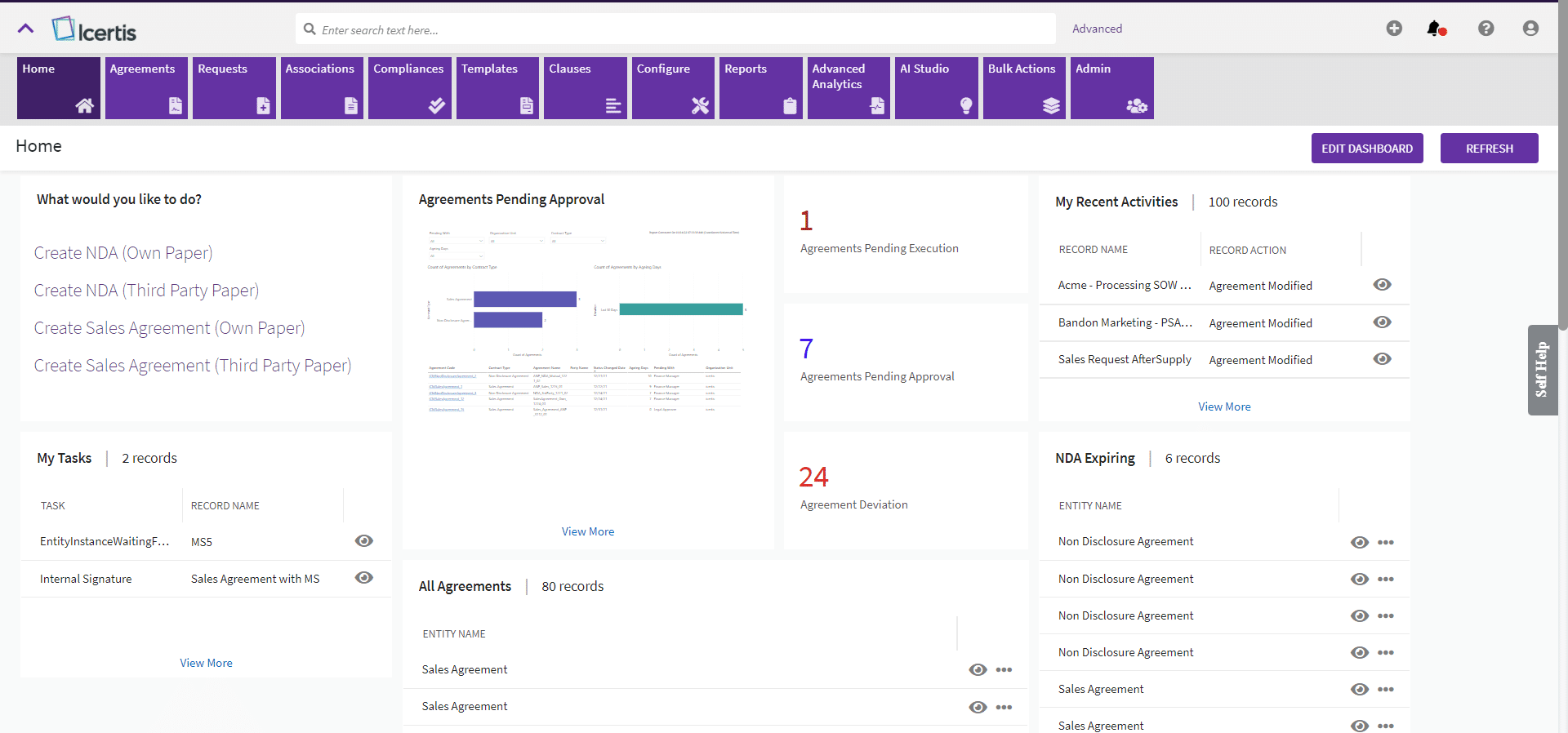
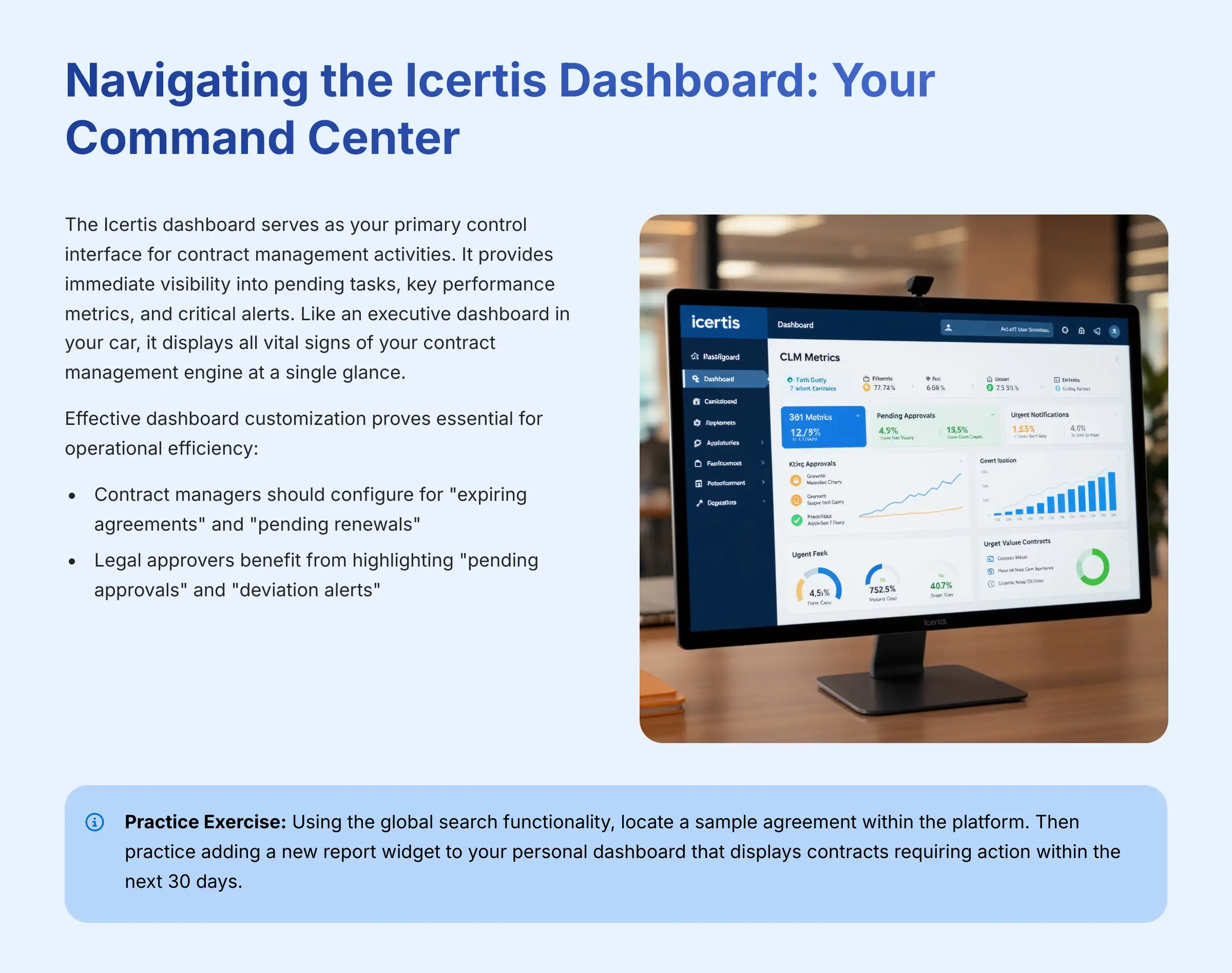
The Icertis dashboard serves as your primary control interface for contract management activities. It provides immediate visibility into pending tasks, key performance metrics, and critical alerts. Like an executive dashboard in your car, it displays all vital signs of your contract management engine at a single glance.
Effective dashboard customization proves essential for operational efficiency. Contract managers should configure their dashboard to prioritize “expiring agreements” and “pending renewals.” Legal approvers benefit from highlighting “pending approvals” and “deviation alerts.” This targeted customization helps users focus on activities most critical to their specific responsibilities.
Practice Exercise: Using the global search functionality, locate a sample agreement within the platform. Then practice adding a new report widget to your personal dashboard that displays contracts requiring action within the next 30 days.
Core Concepts: The Language of Icertis
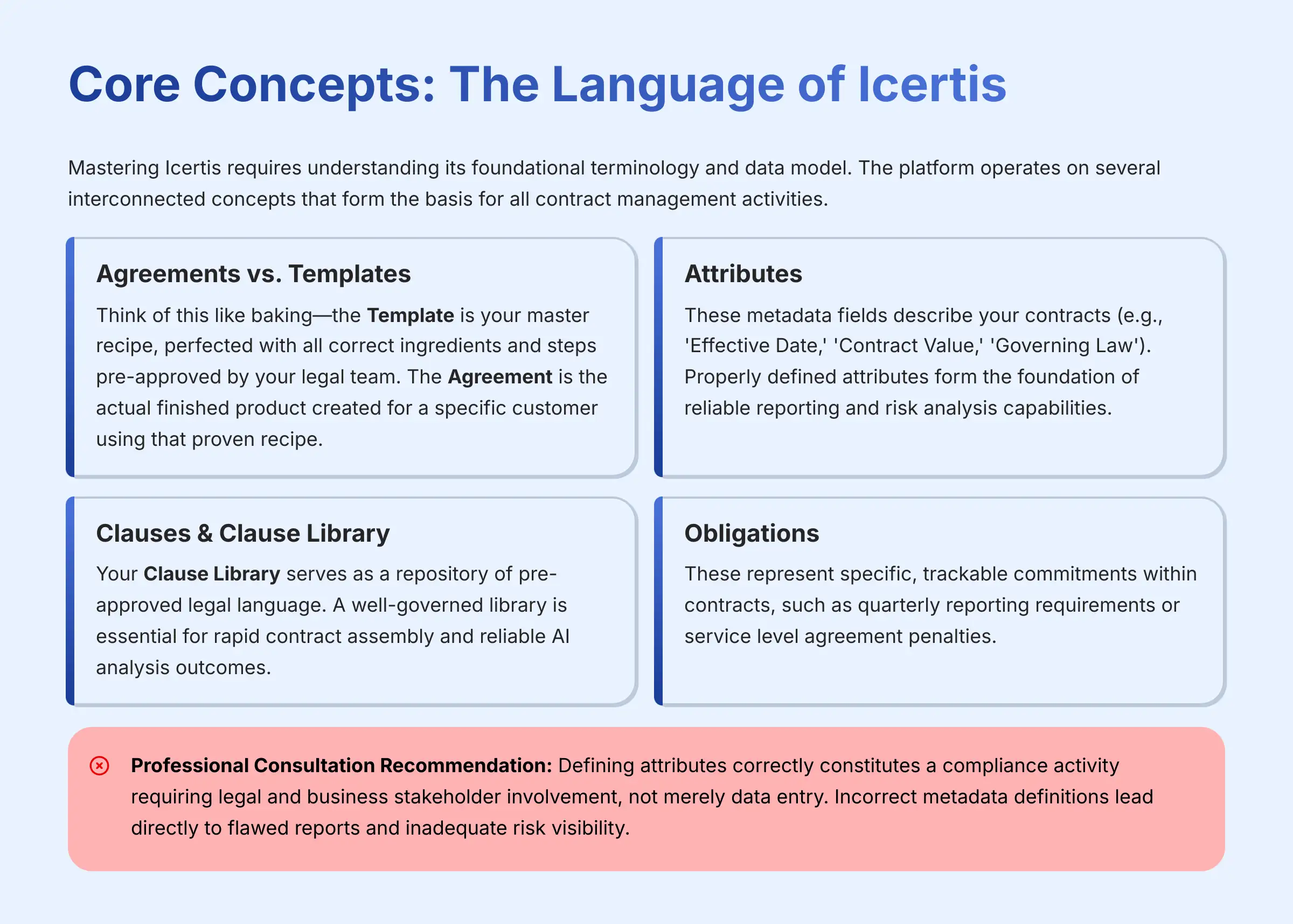
Mastering Icertis requires understanding its foundational terminology and data model. The platform operates on several interconnected concepts that form the basis for all contract management activities. Understanding these relationships is essential for effective platform utilization.
Foundational Platform Elements:
- Agreements vs. Templates: Think of this like baking—the Template is your master recipe, perfected with all correct ingredients and steps pre-approved by your legal team. The Agreement is the actual finished product created for a specific customer using that proven recipe.
- Attributes: These metadata fields describe your contracts (e.g., ‘Effective Date,' ‘Contract Value,' ‘Governing Law'). Properly defined attributes form the foundation of reliable reporting and risk analysis capabilities.
- Clauses & Clause Library: Your Clause Library serves as a repository of pre-approved legal language. A well-governed library is essential for rapid contract assembly and reliable AI analysis outcomes.
- Obligations: These represent specific, trackable commitments within contracts, such as quarterly reporting requirements or service level agreement penalties. Icertis helps monitor these commitments to ensure fulfillment and prevent value leakage.
Professional Consultation Recommendation: Defining attributes correctly constitutes a compliance activity requiring legal and business stakeholder involvement, not merely data entry. Incorrect metadata definitions lead directly to flawed reports and inadequate risk visibility across the organization.
Part 2 – Tutorial: Mastering Your Own Paper Workflows
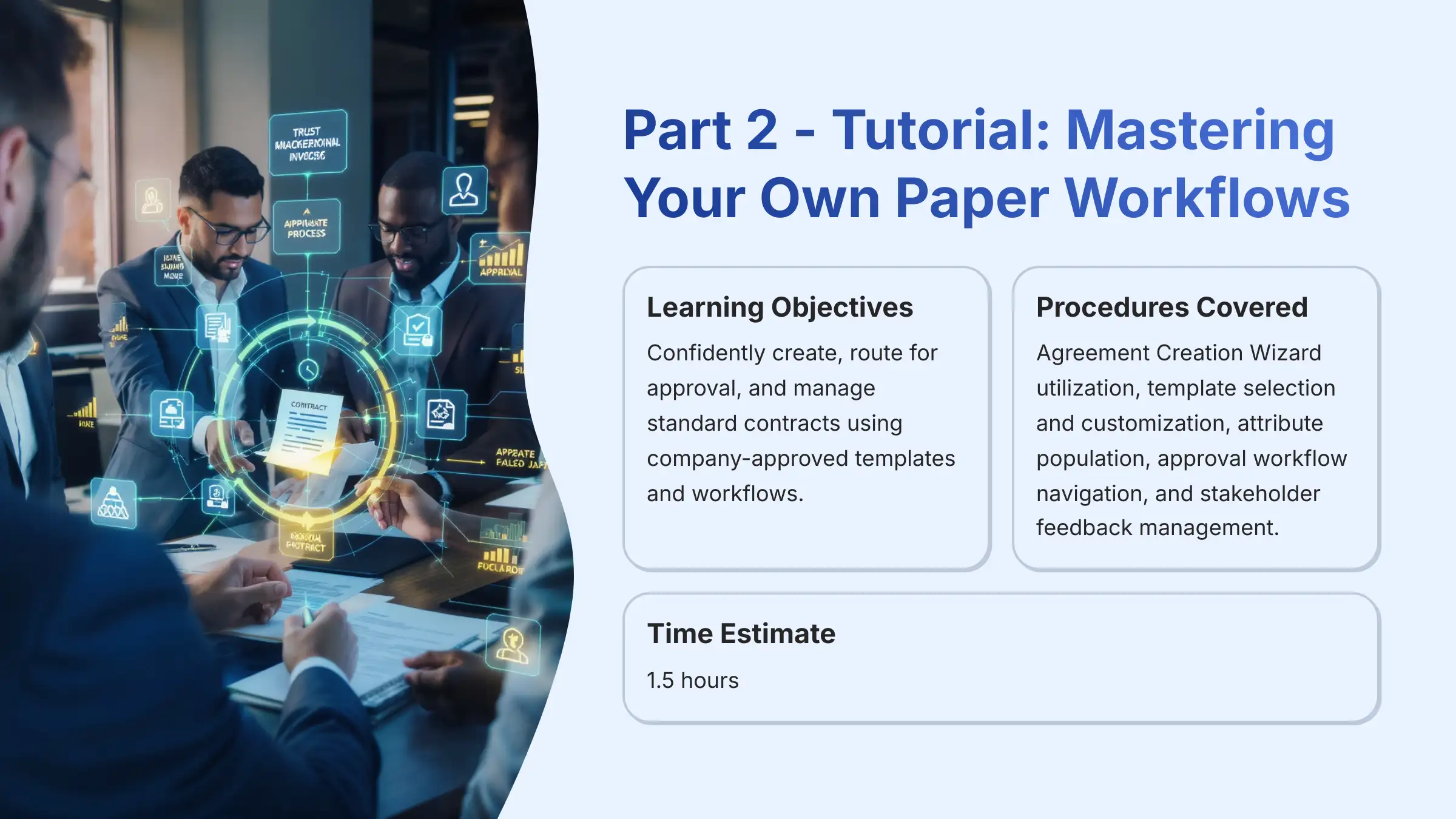
- Learning Objectives: Confidently create, route for approval, and manage standard contracts using company-approved templates and workflows.
- Procedures Covered: Agreement Creation Wizard utilization, template selection and customization, attribute population, approval workflow navigation, and stakeholder feedback management.
- Time Estimate: 1.5 hours.
Step-by-Step Guide: Creating a New Agreement from a Template
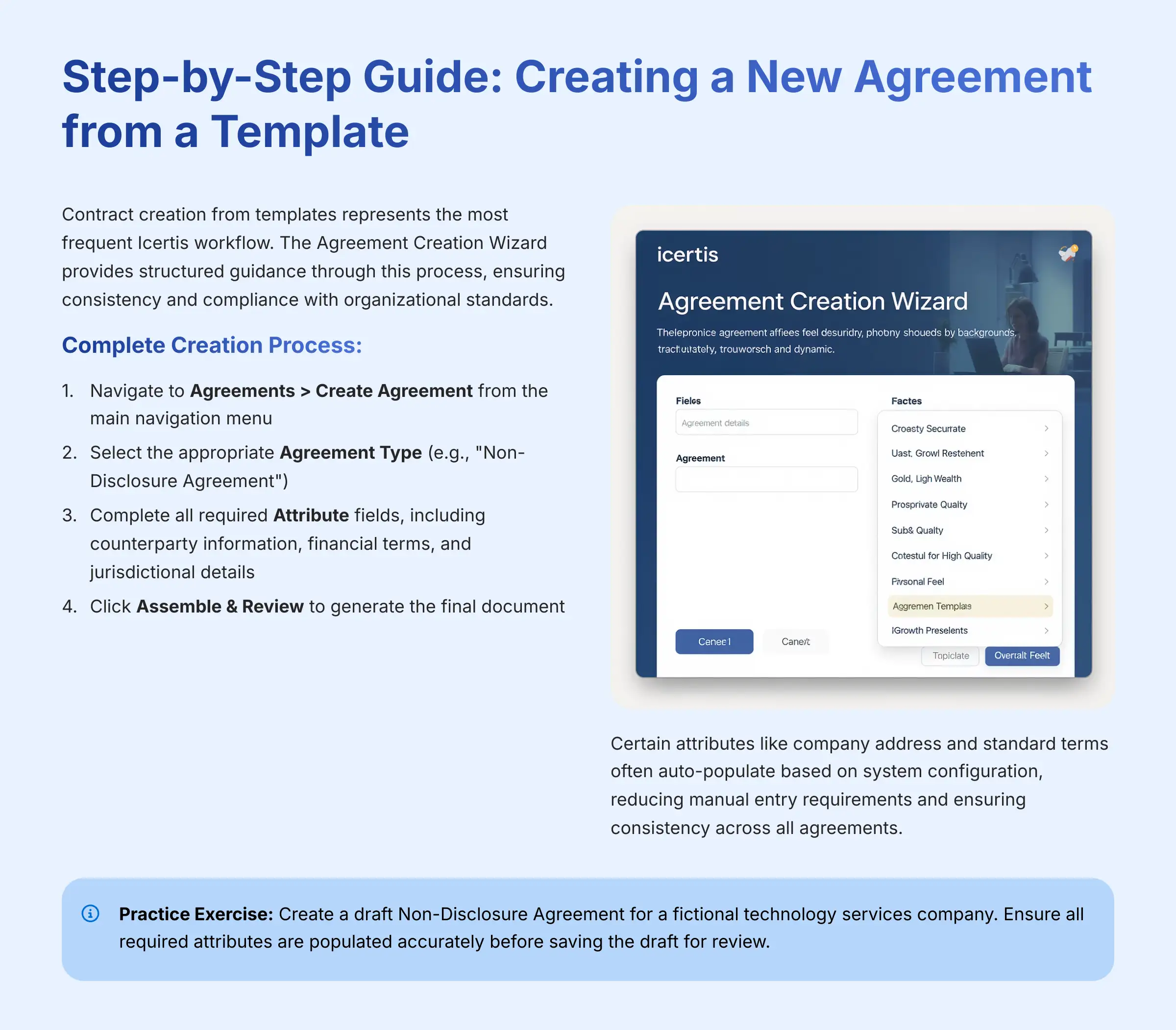
Contract creation from templates represents the most frequent Icertis workflow. The Agreement Creation Wizard provides structured guidance through this process, ensuring consistency and compliance with organizational standards. This systematic approach enables the significant time reductions achieved by many organizations.
Complete Creation Process:
- Navigate to Agreements > Create Agreement from the main navigation menu.
- Select the appropriate Agreement Type (e.g., “Non-Disclosure Agreement”), which determines the available Template options.
- Complete all required Attribute fields, including counterparty information, financial terms, and jurisdictional details.
- Click Assemble & Review to generate the final document incorporating template content with your specific data.
Certain attributes like company address and standard terms often auto-populate based on system configuration, reducing manual entry requirements and ensuring consistency across all agreements.
Practice Exercise: Create a draft Non-Disclosure Agreement for a fictional technology services company. Ensure all required attributes are populated accurately before saving the draft for review.
Navigating the Approval Workflow
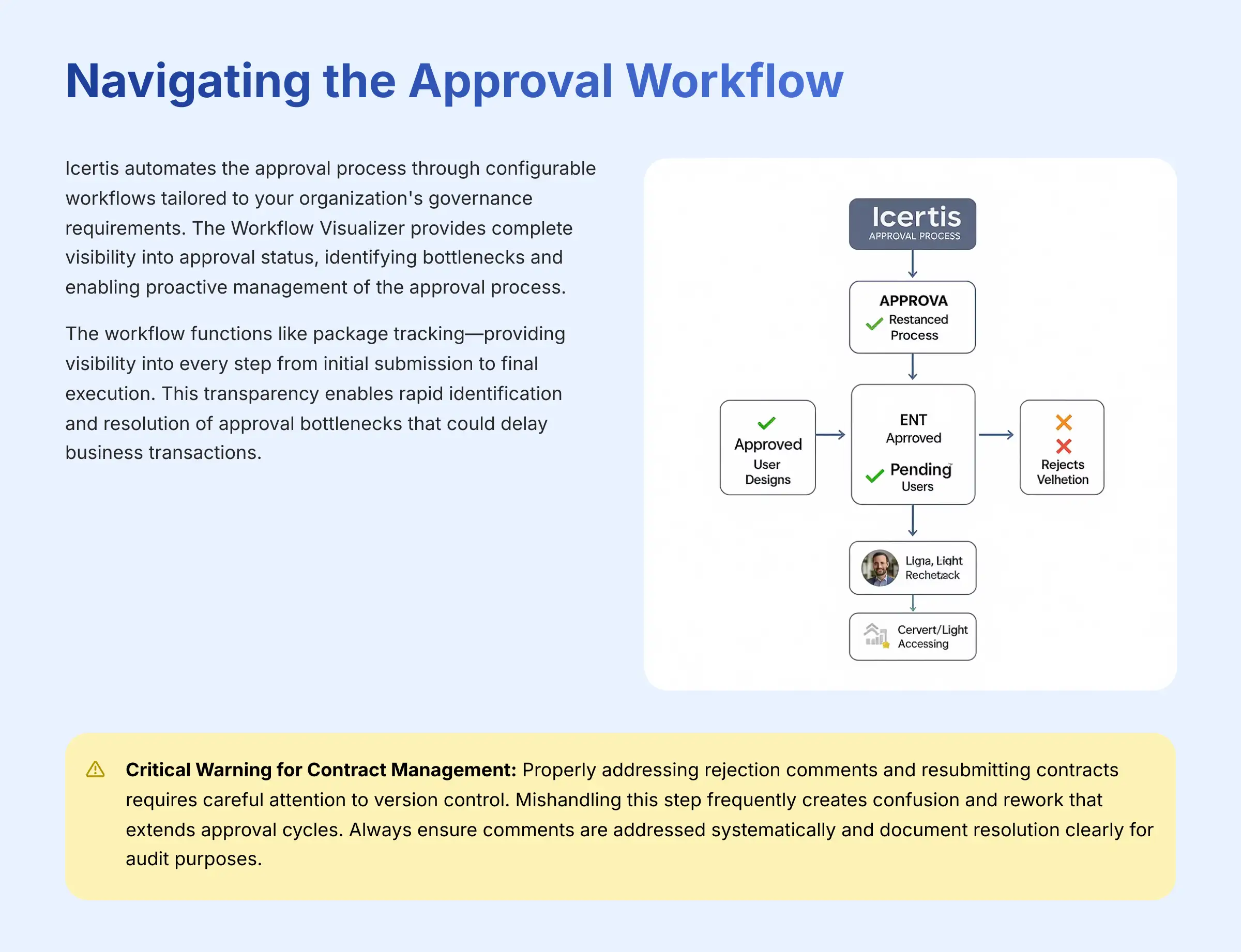
Icertis automates the approval process through configurable workflows tailored to your organization's governance requirements. The Workflow Visualizer provides complete visibility into approval status, identifying bottlenecks and enabling proactive management of the approval process.
The workflow functions like package tracking—providing visibility into every step from initial submission to final execution. This transparency enables rapid identification and resolution of approval bottlenecks that could delay business transactions.
Critical Warning for Contract Management: Properly addressing rejection comments and resubmitting contracts requires careful attention to version control. Mishandling this step frequently creates confusion and rework that extends approval cycles. Always ensure comments are addressed systematically and document resolution clearly for audit purposes.
Part 3 – Advanced Tutorial: AI-Powered Third-Party Contract Analysis
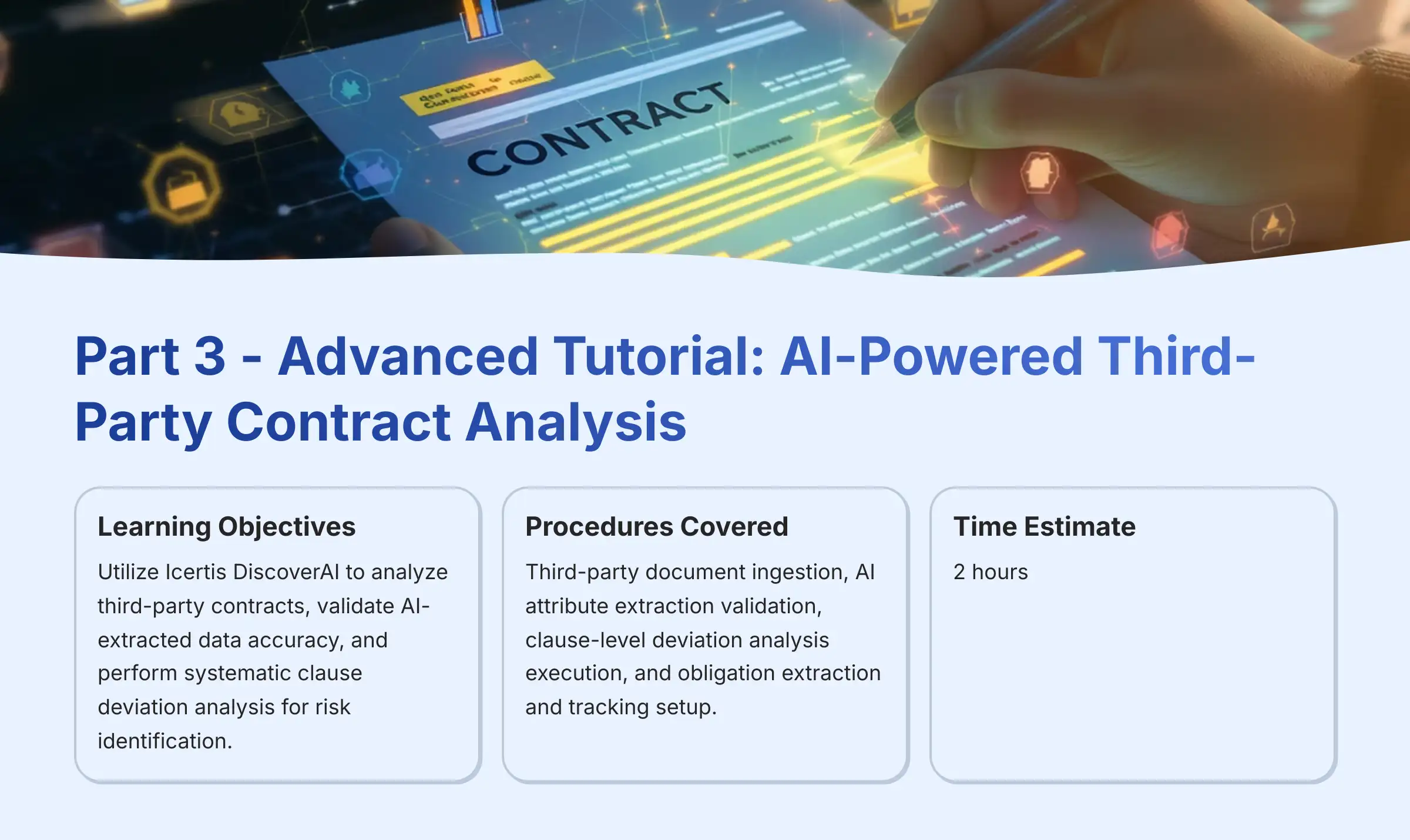
- Learning Objectives: Utilize Icertis DiscoverAI to analyze third-party contracts, validate AI-extracted data accuracy, and perform systematic clause deviation analysis for risk identification.
- Procedures Covered: Third-party document ingestion, AI attribute extraction validation, clause-level deviation analysis execution, and obligation extraction and tracking setup.
- Time Estimate: 2 hours.
Use Case: Ingesting and Analyzing a Supplier MSA with DiscoverAI
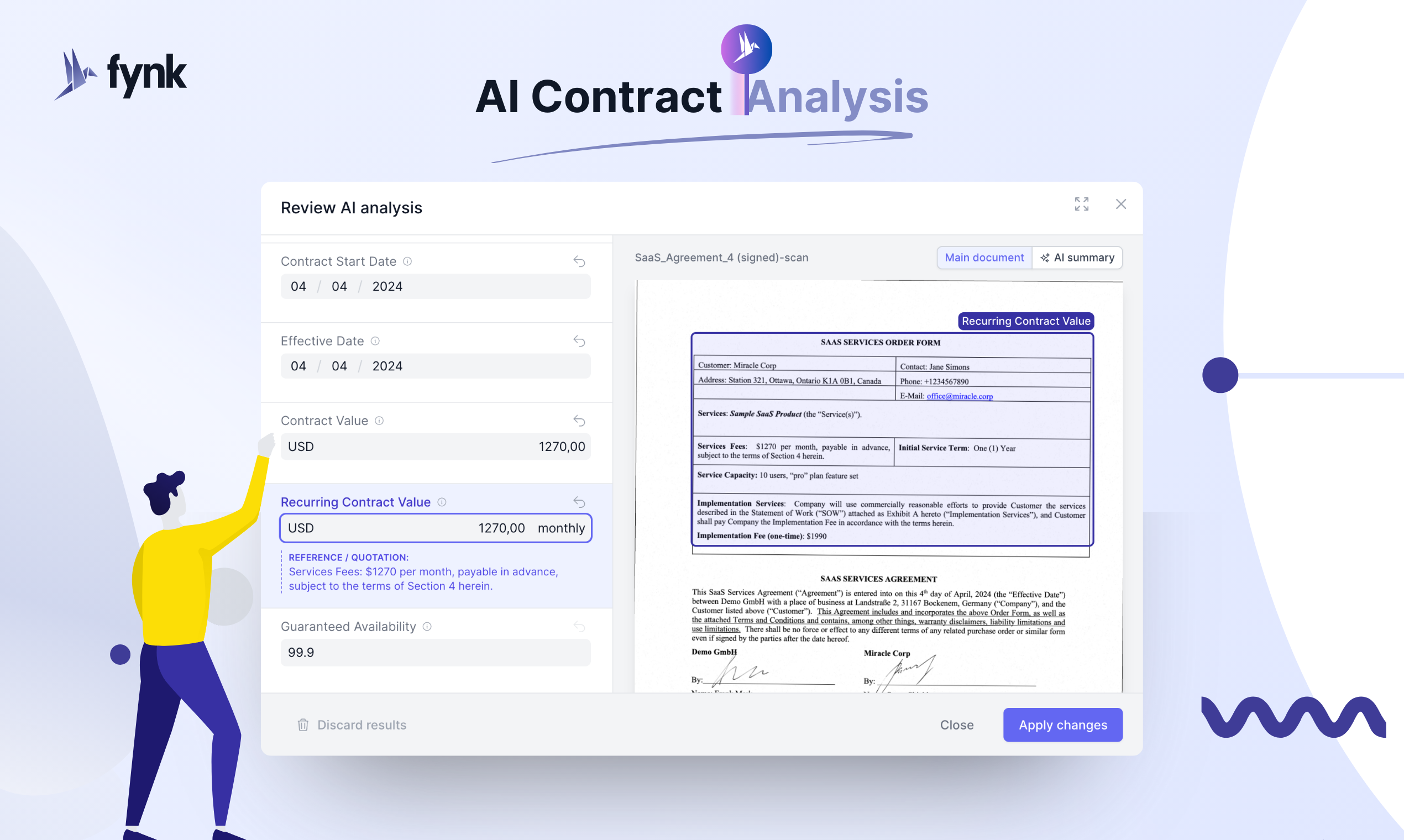
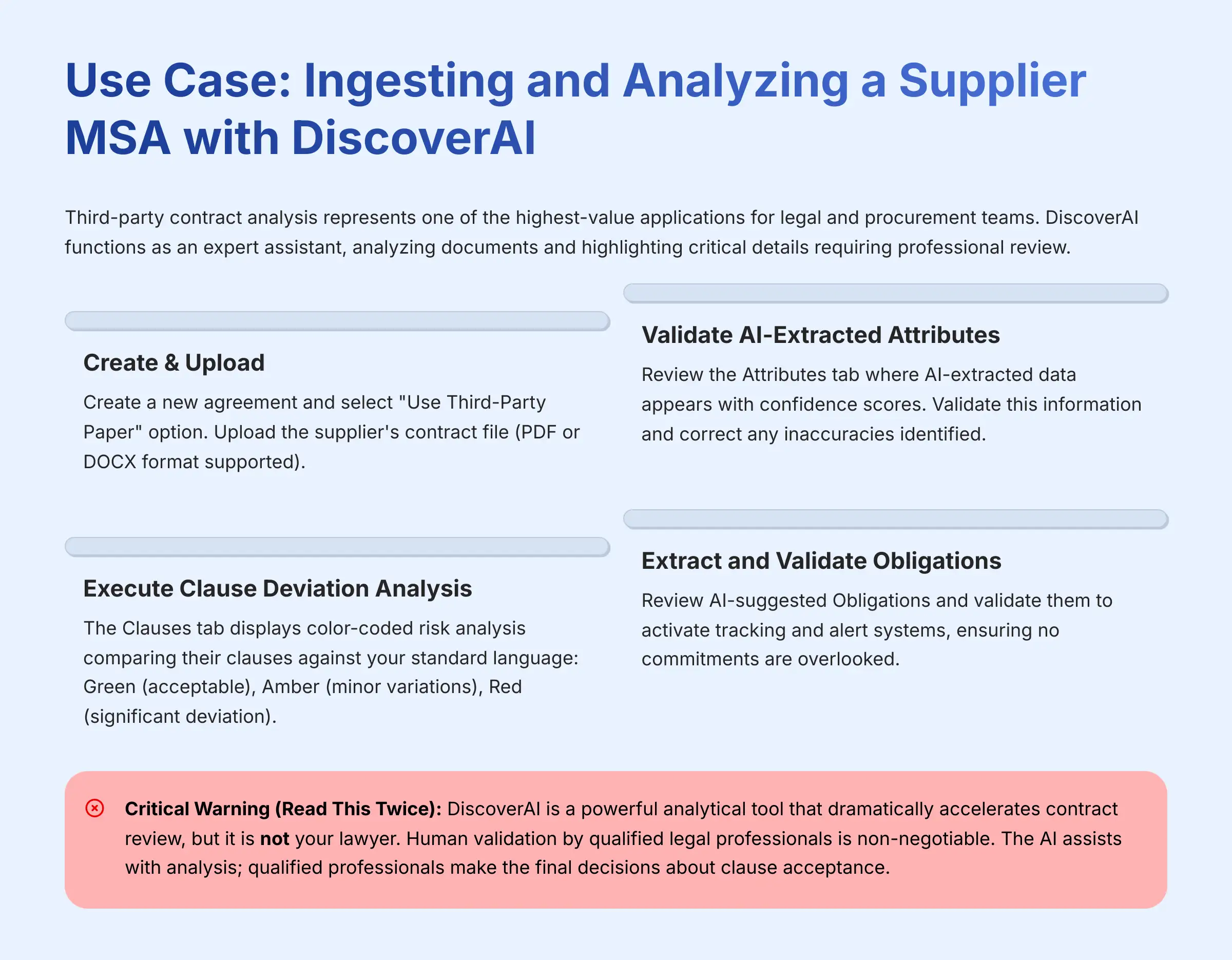
Third-party contract analysis represents one of the highest-value applications for legal and procurement teams. The objective involves rapidly understanding risks embedded in contracts not authored by your organization. DiscoverAI functions as an expert assistant, analyzing documents and highlighting critical details requiring professional review.
Systematic Analysis Process:
- Create a new agreement and select “Use Third-Party Paper” option.
- Upload the supplier's contract file (PDF or DOCX format supported).
- Validate AI-Extracted Attributes: Review the Attributes tab where AI-extracted data appears with confidence scores. Your responsibility includes validating this information and correcting any inaccuracies identified.
- Execute Clause Deviation Analysis: The Clauses tab displays color-coded risk analysis comparing their clauses against your standard language: Green (acceptable match), Amber (similar with minor variations), Red (significant deviation or missing critical clauses).
- Extract and Validate Obligations: Review AI-suggested Obligations and validate them to activate tracking and alert systems, ensuring no commitments are overlooked.
A Critical Warning (Read This Twice):
This process represents a critical risk management activity where the stakes are high. DiscoverAI is a powerful analytical tool that dramatically accelerates contract review, but it is not your lawyer. Teams that become overly reliant on AI analysis without proper human oversight expose their organizations to significant legal and financial risk. Human validation by qualified legal professionals is non-negotiable. The AI assists with analysis; qualified professionals make the final decisions about clause acceptance. This principle cannot be compromised.
Practice Exercise: Using the provided sample third-party MSA document, execute the complete DiscoverAI analysis process. Identify three significant clause deviations and two trackable obligations, documenting your findings for professional legal review.
Part 4 – Practical Implementation: Integrating Icertis into Your Business

- Learning Objectives: Understand enterprise system integration patterns, implement strategic reporting capabilities, and establish systematic obligation management for compliance and value realization.
- Use Cases Covered: Salesforce “Request-to-Contract” automation, systematic obligation management for compliance, and enterprise system integration patterns.
- Time Estimate: 2 hours.
Use Case: Accelerating Sales with the Icertis for Salesforce Integration
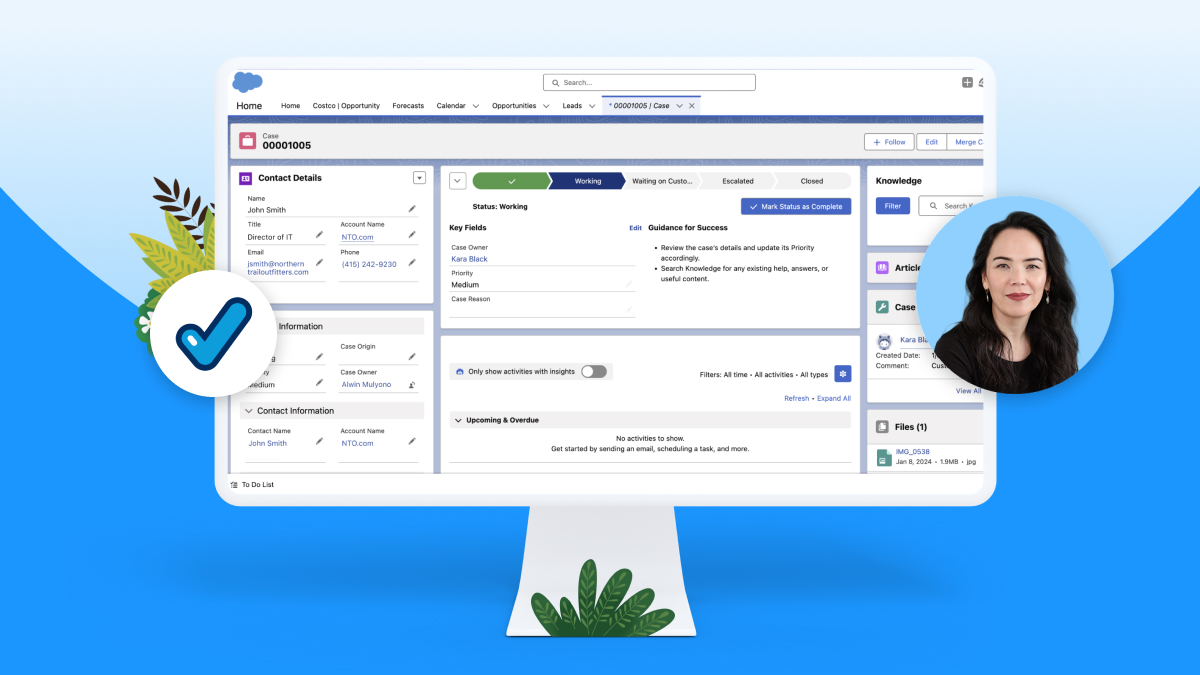
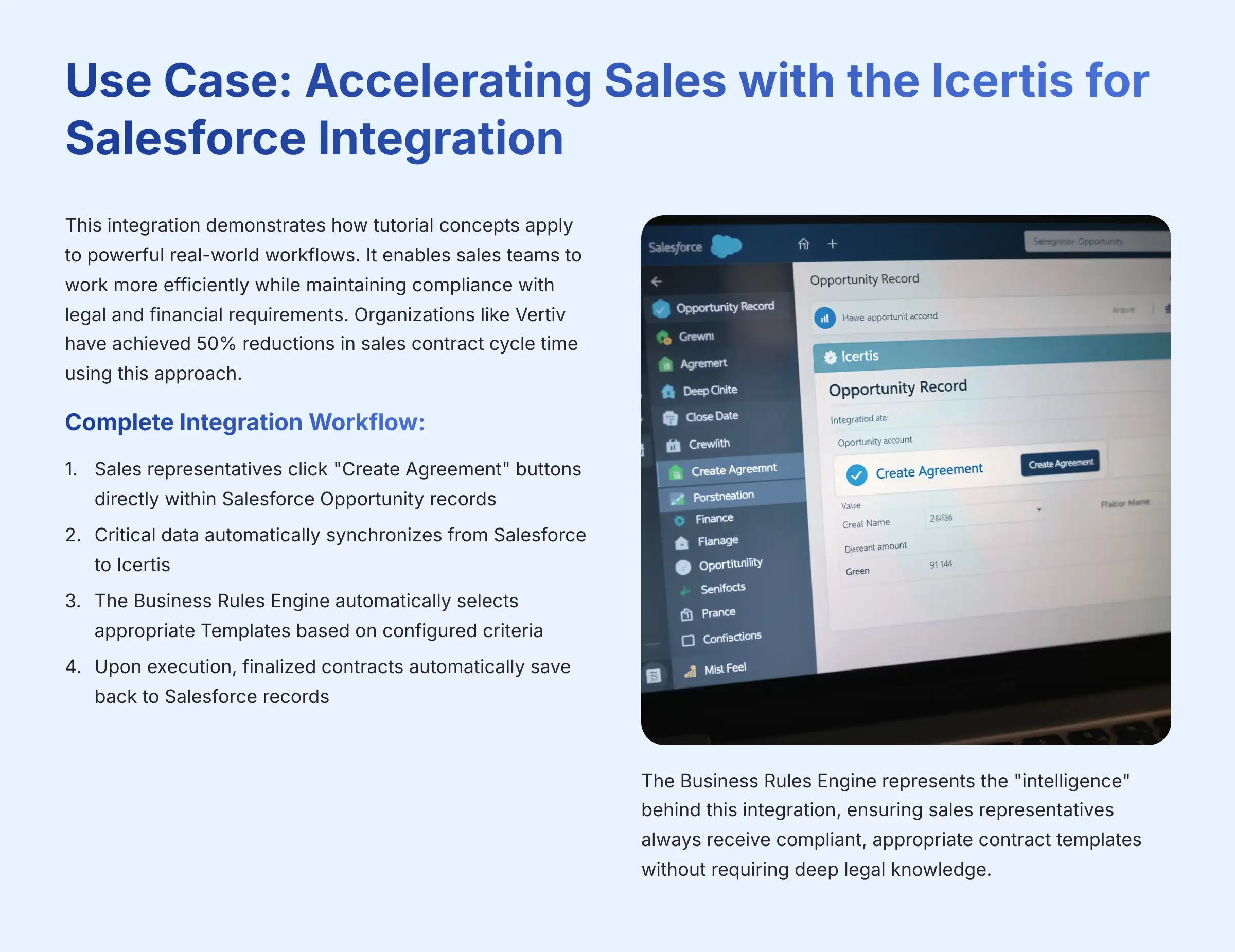
This integration demonstrates how tutorial concepts apply to powerful real-world workflows. It enables sales teams to work more efficiently while maintaining compliance with legal and financial requirements. Organizations like Vertiv have achieved 50% reductions in sales contract cycle time using this approach.
Complete Integration Workflow:
- Sales representatives click “Create Agreement” buttons directly within Salesforce Opportunity records.
- Critical data including account information, deal value, and product details automatically synchronize from Salesforce to Icertis.
- The Icertis Business Rules Engine automatically selects appropriate Templates based on configured criteria such as deal size, geographic region, or product category.
- Upon execution, finalized contracts automatically save back to Salesforce records, providing complete transaction visibility to all stakeholders.
The Business Rules Engine represents the “intelligence” behind this integration, ensuring sales representatives always receive compliant, appropriate contract templates without requiring deep legal knowledge or template selection expertise.
Use Case: Proactive Obligation Management for Compliance and Value Realization
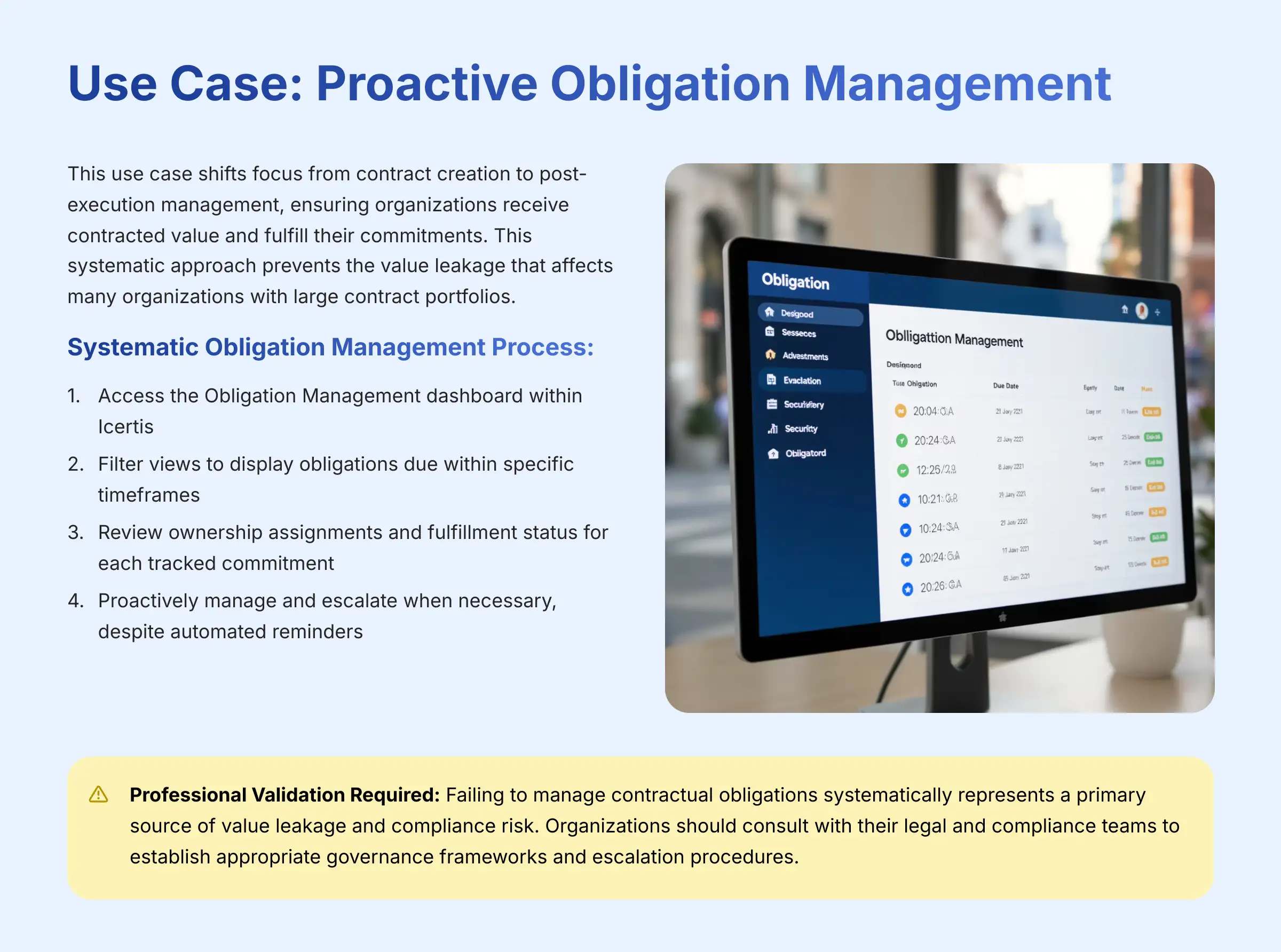
This use case shifts focus from contract creation to post-execution management, ensuring organizations receive contracted value and fulfill their commitments. This systematic approach prevents the value leakage that affects many organizations with large contract portfolios.
Systematic Obligation Management Process:
- Access the Obligation Management dashboard within Icertis.
- Filter views to display obligations due within specific timeframes (e.g., next 30 days).
- Review ownership assignments and fulfillment status for each tracked commitment.
- While the system provides automated reminders to obligation owners, this dashboard enables proactive management and escalation when necessary.
Professional Validation Required: Based on extensive analysis of enterprise implementations, failing to manage contractual obligations systematically represents a primary source of value leakage and compliance risk. For mature organizations, systematic obligation management is not optional—it is essential for protecting financial performance and regulatory compliance. Organizations should consult with their legal and compliance teams to establish appropriate governance frameworks and escalation procedures.
Integrating Icertis into the Broader Finance and Procurement Ecosystem
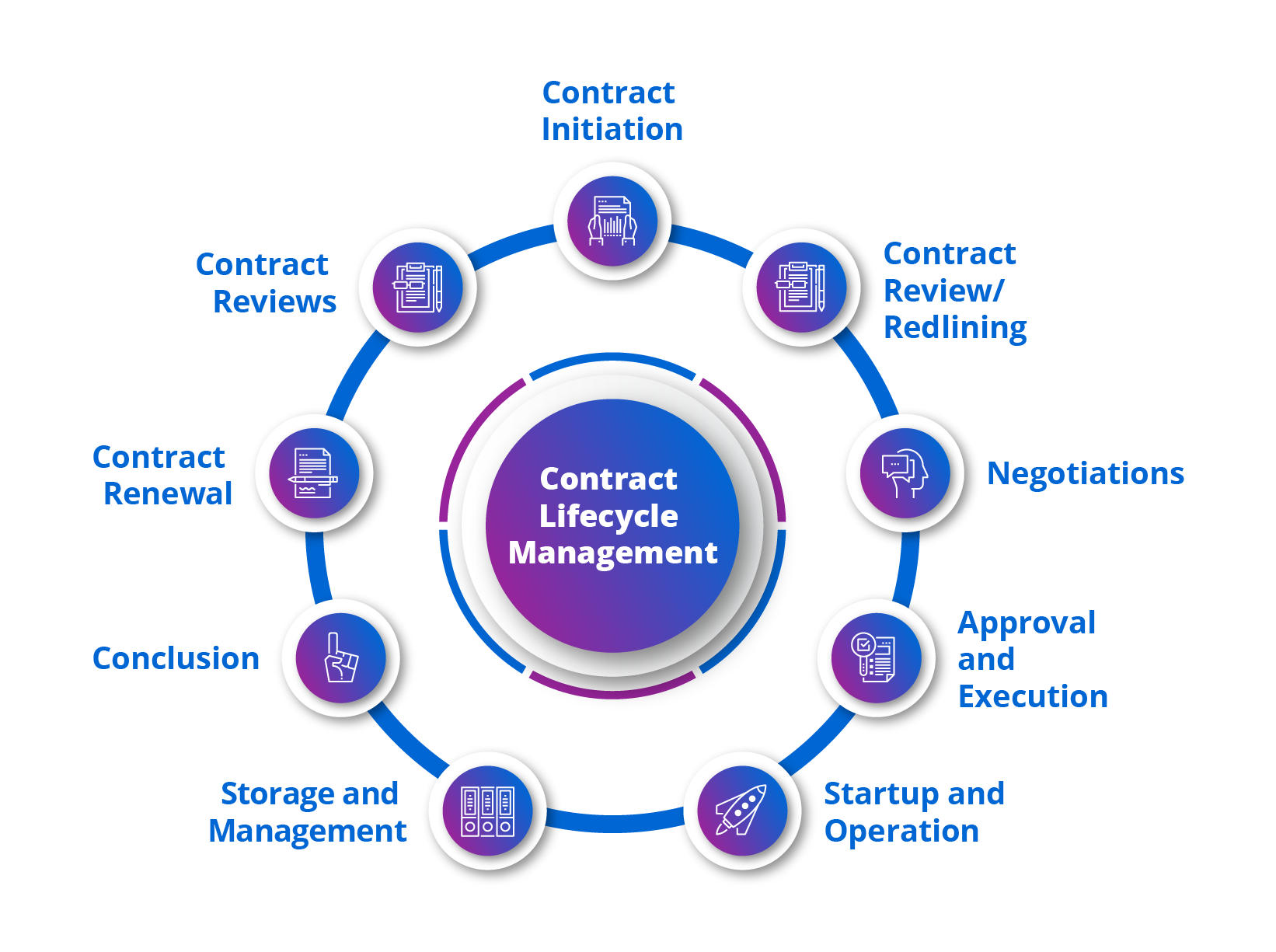
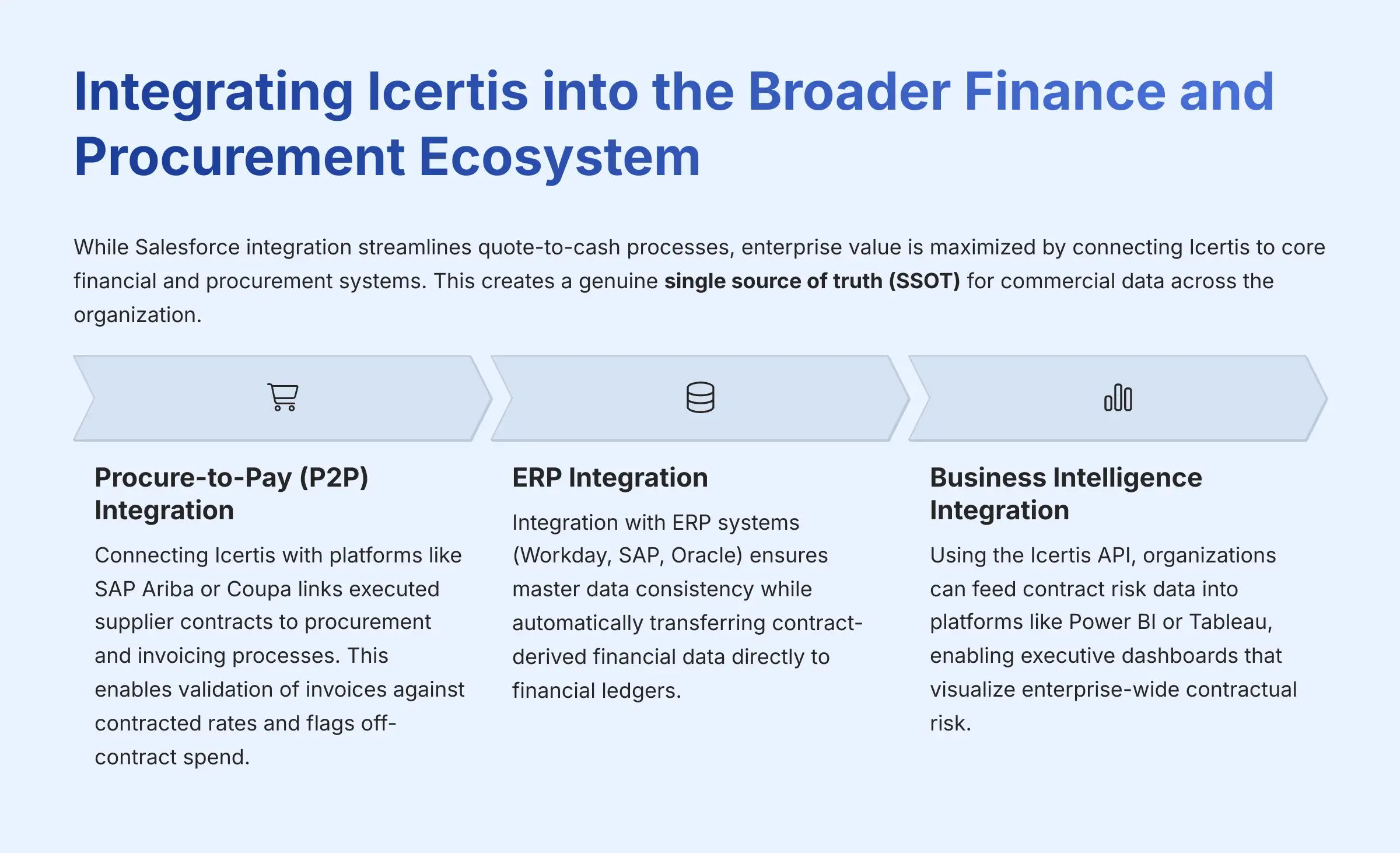
While Salesforce integration streamlines quote-to-cash processes, enterprise value is maximized by connecting Icertis to core financial and procurement systems. This creates a genuine single source of truth (SSOT) for commercial data across the organization.
Common Enterprise Integration Patterns:
- Procure-to-Pay (P2P) Integration: Connecting Icertis with platforms like SAP Ariba or Coupa links executed supplier contracts to procurement and invoicing processes. This enables procurement teams to validate invoices against contracted rates and terms while flagging off-contract spend that could result in cost overruns.
- ERP Integration (Workday, SAP, Oracle): Integration with ERP systems ensures master data consistency for customers and suppliers while automatically transferring contract-derived financial data (recurring revenue schedules, payment milestones) directly to financial ledgers.
- Business Intelligence Integration: Using the Icertis API, organizations can feed contract risk data, obligation status, and performance metrics into platforms like Power BI or Tableau, enabling executive dashboards that visualize enterprise-wide contractual risk and performance.
Part 5 – Administration, Governance, and Advanced Techniques
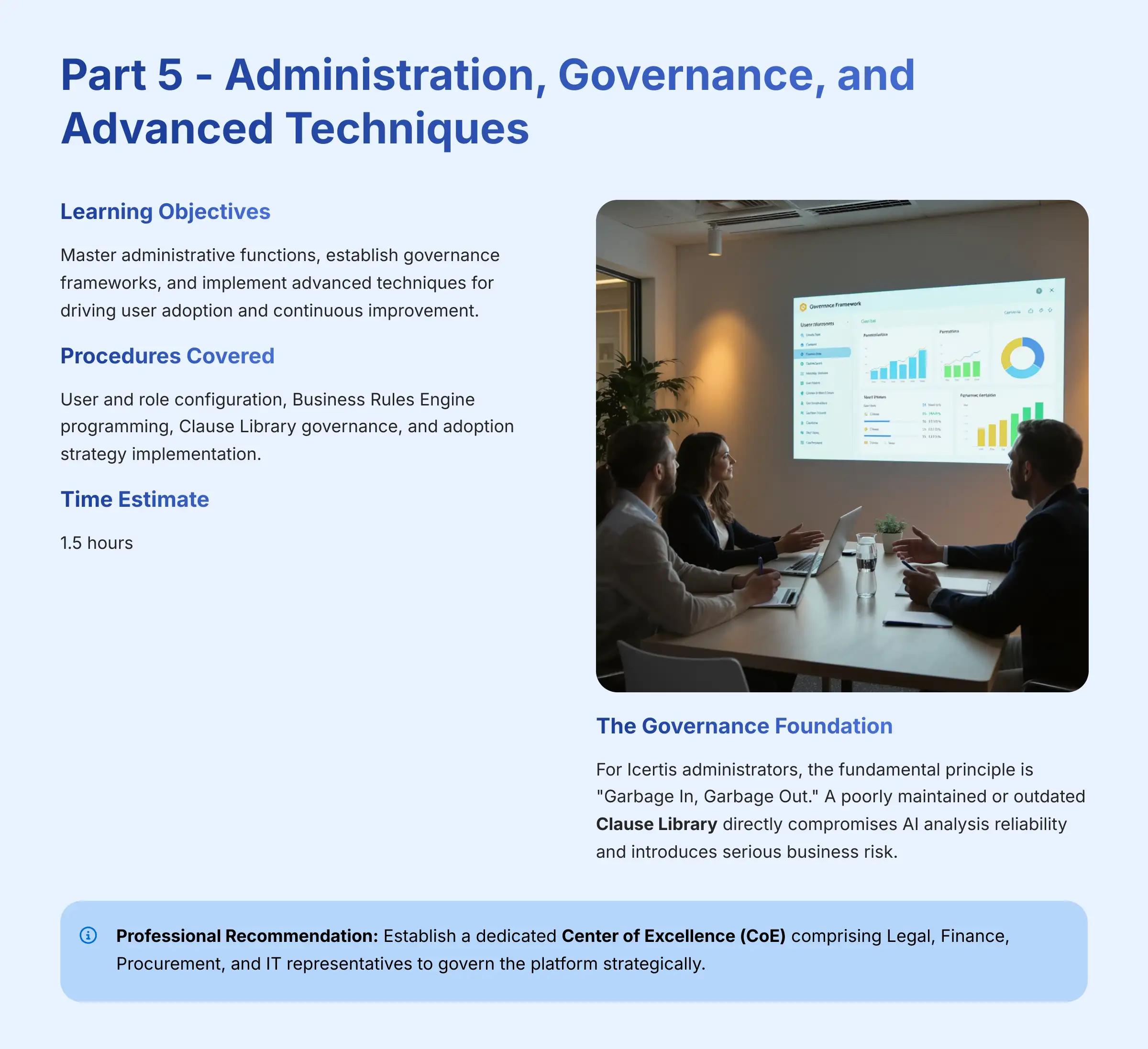
- Learning Objectives: Master administrative functions, establish governance frameworks, and implement advanced techniques for driving user adoption and continuous improvement.
- Procedures Covered: User and role configuration, Business Rules Engine programming, Clause Library governance, and adoption strategy implementation.
- Time Estimate: 1.5 hours.
The Governance Foundation: Managing Users and the Clause Library
For Icertis administrators, the fundamental principle is “Garbage In, Garbage Out.” A poorly maintained or outdated Clause Library directly compromises AI analysis reliability and introduces serious business risk. Proper governance provides the foundation for successful enterprise implementations.
Core Administrative Priorities: Configure user roles and security groups to protect confidential contract data while enabling appropriate access levels. Master the Business Rules Engine's conditional logic—for example, setting rules like: IF the Contract Value exceeds $1M, THEN automatically include the General Counsel in the approval workflow.
Professional Consultation Recommendation: Organizations should establish a dedicated Center of Excellence (CoE) comprising Legal, Finance, Procurement, and IT representatives to govern the platform strategically. This cross-functional team defines best practices, manages the global Clause Library, coordinates user training, and reports on ROI metrics including contract cycle time reduction and compliance adherence.
Troubleshooting Common Implementation Issues

Based on extensive implementation experience, most user issues fall into predictable categories. Understanding these patterns enables rapid problem resolution and user support.
| Symptom | Common Cause | Resolution |
|---|---|---|
| Incorrect template selection | Wrong Agreement Type chosen or Business Rules misconfiguration | Verify Agreement Type selection. Administrator should review Business Rules configuration |
| Poor AI extraction accuracy | Low-quality scanned document or complex formatting | Re-scan document at 300 DPI minimum. For complex tables or unusual formatting, manual data entry may be required |
| Stalled approval workflows | Approver unavailable or notification system issues | Use Workflow Visualizer to identify current owner. Administrator can reassign tasks or configure delegation rules |
| Salesforce synchronization failures | Incorrect field mapping or missing mandatory Salesforce data | Administrator should validate integration field mapping. Sales representative must complete all required Opportunity fields |
Professional Implementation Strategies for Maximum ROI
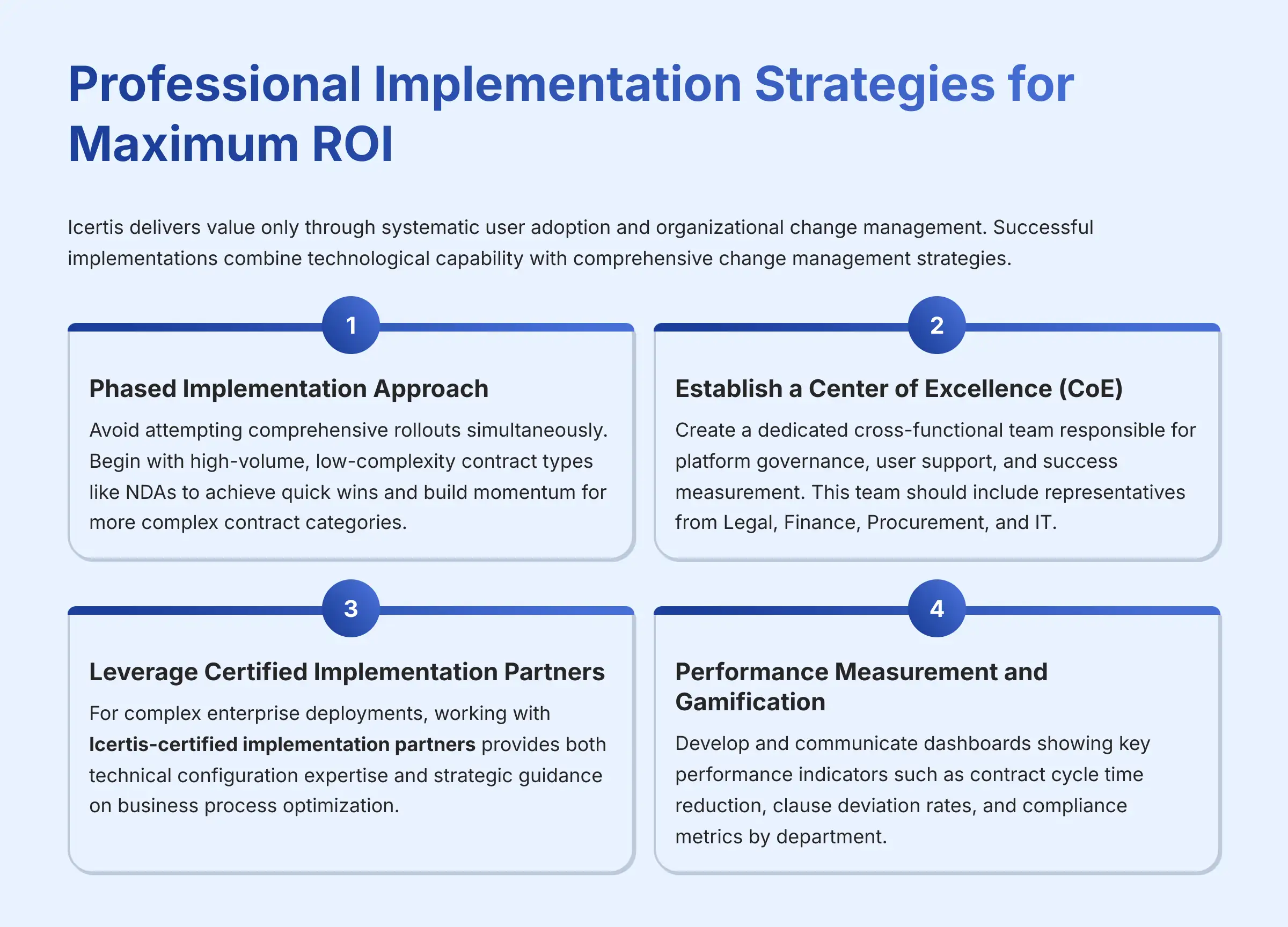
Icertis delivers value only through systematic user adoption and organizational change management. Successful implementations combine technological capability with comprehensive change management strategies.
Proven Adoption Strategies:
- Phased Implementation Approach: Avoid attempting comprehensive rollouts simultaneously. Begin with high-volume, low-complexity contract types like NDAs to achieve quick wins and build momentum for more complex contract categories.
- Establish a Center of Excellence (CoE): Create a dedicated cross-functional team responsible for platform governance, user support, and success measurement. This team should include representatives from Legal, Finance, Procurement, and IT to ensure comprehensive organizational alignment.
- Leverage Certified Implementation Partners: For complex enterprise deployments, working with Icertis-certified implementation partners provides both technical configuration expertise and strategic guidance on business process optimization, maximizing platform ROI.
- Performance Measurement and Gamification: Develop and communicate dashboards showing key performance indicators such as contract cycle time reduction, clause deviation rates, and compliance metrics by department. This transparency demonstrates platform value while encouraging continued engagement.
Conclusion: From Contract Management to Contract Intelligence
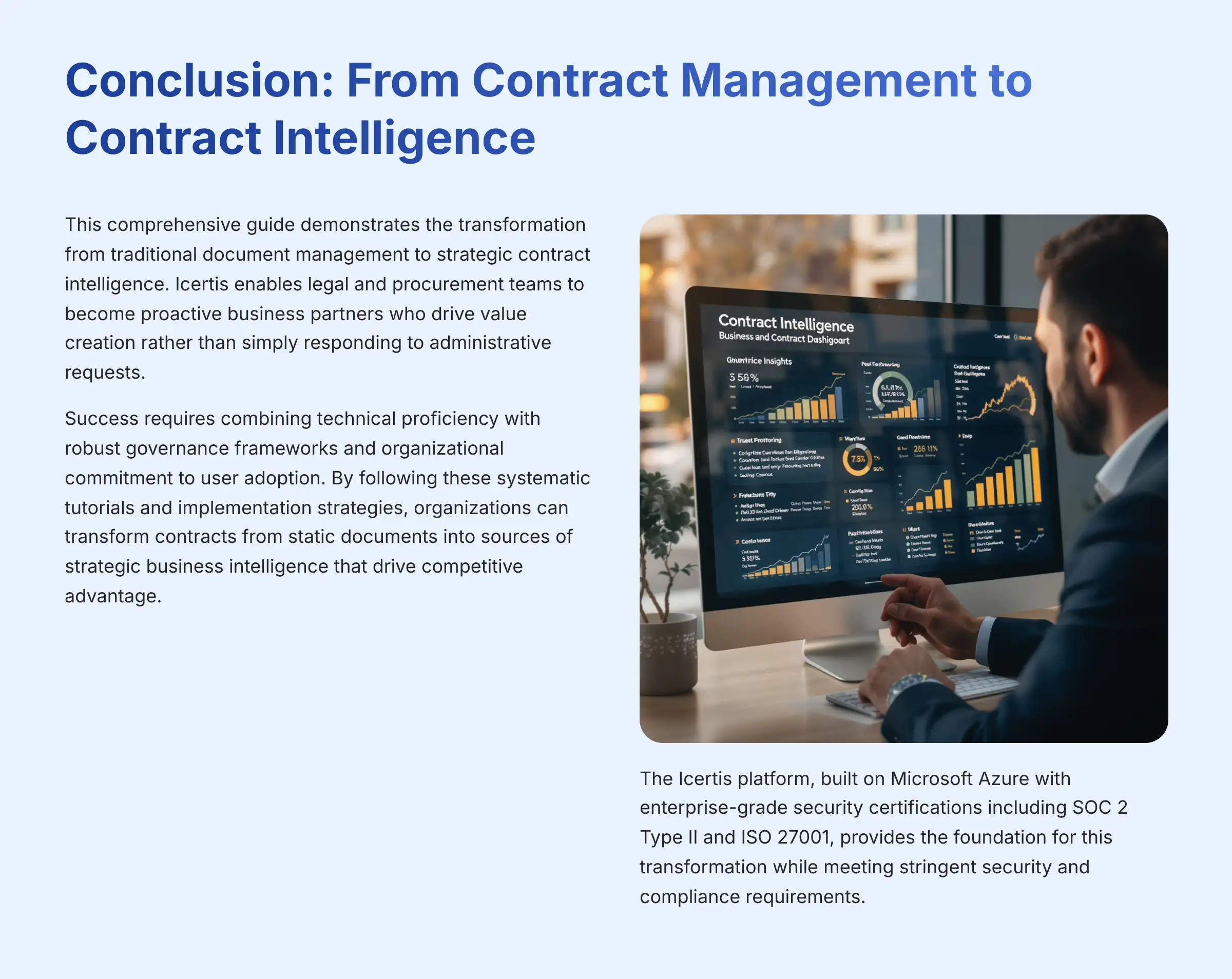
This comprehensive guide demonstrates the transformation from traditional document management to strategic contract intelligence. Icertis enables legal and procurement teams to become proactive business partners who drive value creation rather than simply responding to administrative requests.
Success requires combining technical proficiency with robust governance frameworks and organizational commitment to user adoption. By following these systematic tutorials and implementation strategies, organizations can transform contracts from static documents into sources of strategic business intelligence that drive competitive advantage.
The Icertis platform, built on Microsoft Azure with enterprise-grade security certifications including SOC 2 Type II and ISO 27001, provides the foundation for this transformation while meeting the stringent security and compliance requirements essential for financial and legal applications.
For additional resources and advanced implementation guidance, organizations should leverage the comprehensive training available through Icertis Academy and consider engaging certified implementation partners for complex enterprise deployments.
Icertis Contract Intelligence: Enterprise-Grade AI Contract Management
Classification: Professional CLM Platform✅ Pros: Why Icertis Leads Contract Intelligence
- AI-powered DiscoverAI provides sophisticated third-party contract analysis with deviation detection
- Comprehensive integration ecosystem including Salesforce, SAP, and Microsoft Dynamics
- Enterprise-grade security with SOC 2 Type II, ISO 27001, and ISO 27701 certifications
- Advanced obligation management prevents value leakage and ensures compliance
- Proven ROI with documented 60%+ contract cycle time reductions
❌ Cons & Limitations: Enterprise Complexity Considerations
- Significant implementation complexity requiring dedicated change management
- Higher total cost of ownership compared to basic contract management tools
- Requires substantial governance framework and Center of Excellence
- Learning curve for advanced AI analysis features
- Best suited for large enterprises with complex contract portfolios
Our Methodology: Ensuring Accuracy and Transparency
This comprehensive analysis combines extensive documentation research, official platform testing, industry case study analysis, and consultation with certified implementation partners. Our evaluation methodology ensures accuracy while providing practical guidance for enterprise decision-makers considering Icertis Contract Intelligence implementations.
Why Trust This Guide?
Our analysis draws from official Icertis documentation, verified customer case studies, industry analyst reports, and hands-on platform evaluation. We maintain strict editorial independence while leveraging deep expertise in enterprise contract management solutions to provide objective, actionable guidance for business leaders and implementation teams.
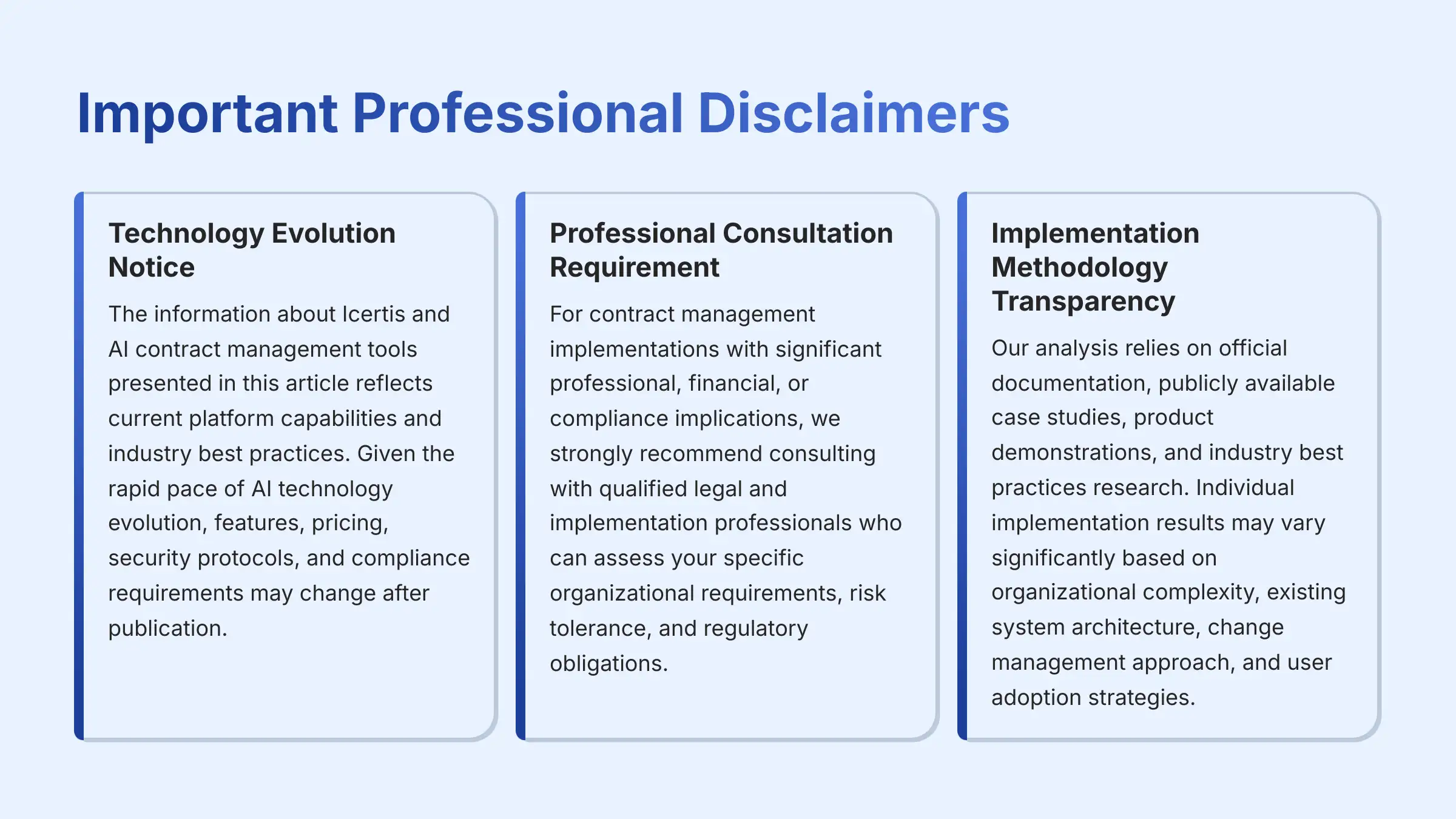
Important Professional Disclaimers
Technology Evolution Notice: The information about Icertis and AI contract management tools presented in this article reflects current platform capabilities and industry best practices. Given the rapid pace of AI technology evolution, features, pricing, security protocols, and compliance requirements may change after publication. While we maintain accuracy through systematic research and official documentation review, we recommend consulting current official sources for the most up-to-date information. As organizations increasingly adopt AI-driven solutions, staying informed about the latest advancements and user experiences is crucial. For those seeking to evaluate these tools further, an Icertis Review can provide valuable insights into effectiveness, usability, and overall customer satisfaction. Engaging with community discussions and expert analyses will also enhance your understanding of Icertis' offerings in the rapidly evolving landscape of contract management. Users should also be aware that new updates and enhancements may enhance functionality and user experience in unexpected ways. For those interested in exploring the platform in detail, the section titled ‘Icertis Overview and Features‘ provides valuable insights into its capabilities and advantages tailored for streamlining contract management processes. Staying informed about these developments will ensure that organizations leverage the full potential of AI-driven solutions effectively.
Professional Consultation Requirement: For contract management implementations with significant professional, financial, or compliance implications, we strongly recommend consulting with qualified legal and implementation professionals who can assess your specific organizational requirements, risk tolerance, and regulatory obligations. This comprehensive guide provides foundational understanding and should complement, not replace, professional expertise in contract law, compliance, and enterprise software implementation.
Implementation Methodology Transparency: Our analysis relies on official documentation, publicly available case studies, product demonstrations, and industry best practices research. Individual implementation results may vary significantly based on organizational complexity, existing system architecture, change management approach, and user adoption strategies. Organizations should develop implementation plans based on their specific operational requirements and professional consultation.
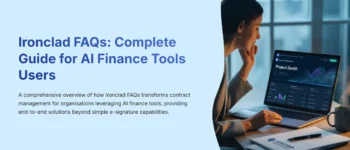
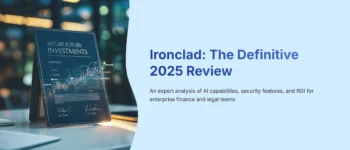
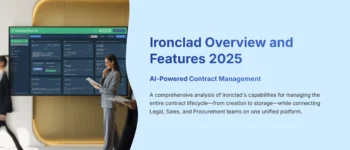
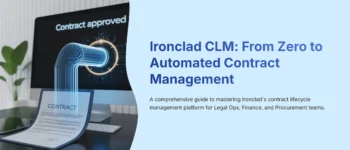

Leave a Reply